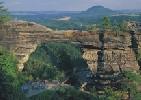 |
|
Conference venue, accommodation and arrival Conference background and aims Bohemian Switzerland National Park |
Sandstone Landscapes: Diversity, Ecology and Conservation 14 - 20 September, 2002
|
|
| Background and aims of the conference | |
There are many sandstone regions scattered over Europe. They host specific flora and fauna; they support landscapes where dynamic geomorphological processes occur at rates unseen in landscapes that surround them. The pronounced geomorphological gradients create strong gradients in mesoclimatic conditions and vegetation zone inversions; in addition, they generate high levels of natural disturbance and resulting patch dynamics. Recently, they have often witnessed disastrous spread of invasive species; although the true reason is unknown, it may be facilitated by the fact that these habitats support so many highly disturbed patches ideally suited for an opportunistic plant invader. All these features make them very distinct from the surrounding landscapes, both now and in the past. Much of the Holocene they seem to have supported ecosystems and species markedly different from the other landscapes; some of the species occurring there are of distinctly relict nature. Much later, when agricultural practices changed the European landscape, sandstone regions usually remained forested to a much greater degree than other landscape types. Sandstones are not only a phenomenon of geological and biological interest. Strong geomorphological gradients forced people living there to adopt specific agricultural practices and to live in specific kinds of settlements. Bizarre landscapes of sandstone regions have attracted human attention, particularly since the Romantic period; then they became major tourist destinations with a specific settlement structure developing around an early tourist industry. We believe the uniqueness of gemorphologic and ecological processes in
sandstone regions calls for a much more intimate link between geomorphology, climatology,
landscape history and biology/ecology. We see this as a challenge for science: in no other
landscape type botanical research would be in a stronger need for data on geomorphology,
or a geomorphologist on hydrology; many similar examples can be named. A tentative list of
topics that we consider really interesting may include:
(These subjects are, quite naturally, shaped by the organizers' experience of Central European sandstones only. Still we hope that they may provide a starting point for further discussions and research.) Quite surprisingly, there has not been a systematic effort devoted to bridging all these disciplines to show the real uniqueness of sandstone regions in geological, ecological and historical context. Therefore we decided to organize a conference devoted specifically to sandstones, while not restricted to any particular scientific field. We hope that this conference will
|
|
